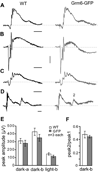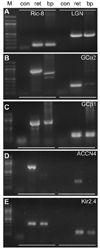Probing neurochemical structure and function of retinal ON bipolar cells with a transgenic mouse
- PMID: 18671302
- PMCID: PMC2854669
- DOI: 10.1002/cne.21807
Probing neurochemical structure and function of retinal ON bipolar cells with a transgenic mouse
Abstract
Retinal ON bipolar cells make up about 70% of all bipolar cells. Glutamate hyperpolarizes these cells by binding to the metabotropic glutamate receptor mGluR6, activating the G-protein G(o1), and closing an unidentified cation channel. To facilitate investigation of ON bipolar cells, we here report on the production of a transgenic mouse (Grm6-GFP) in which enhanced green fluorescent protein (EGFP), under control of mGluR6 promoter, was expressed in all and only ON bipolar cells. We used the mouse to determine density of ON bipolar cells, which in central retina was 29,600 cells/mm(2). We further sorted the fluorescent cells and created a pure ON bipolar cDNA library that was negative for photoreceptor unique genes. With this library, we determined expression of 27 genes of interest. We obtained positive transcripts for G(o) interactors: regulators of G-protein signaling (RGS), Ret-RGS1 (a variant of RGS20), RGS16, RGS7, purkinje cell protein 2 (PCP2, also called L7 or GPSM4), synembryn (RIC-8), LGN (GPSM2), RAP1GAP, and Gbeta5; cGMP modulators: guanylyl cyclase (GC) 1alpha1, GC1beta1, phosphodiesterase (PDE) 1C, and PDE9A; and channels: inwardly rectifying potassium channel Kir2.4, transient receptor potential TRPC2, and sperm-specific cation channels CatSper 2-4. The following transcripts were not found in our library: AGS3 (GPSM1), RGS10, RGS19 (GAIP), calbindin, GC1alpha2, GC1beta2, PDE5, PDE2A, amiloride-sensitive sodium channel ACCN4, and CatSper1. We then localized Kir2.4 to several cell types and showed that, in ON bipolar cells, the channel concentrates in their dendritic tips. The channels and modulators found in ON bipolar cells likely shape their light response. Additional uses of the Grm6-GFP mouse are also discussed.
Figures








Similar articles
-
Gbeta5-RGS complexes co-localize with mGluR6 in retinal ON-bipolar cells.Eur J Neurosci. 2007 Nov;26(10):2899-905. doi: 10.1111/j.1460-9568.2007.05867.x. Eur J Neurosci. 2007. PMID: 18001285 Free PMC article.
-
Lack of mGluR6-related cascade elements leads to retrograde trans-synaptic effects on rod photoreceptor synapses via matrix-associated proteins.Eur J Neurosci. 2016 Jun;43(11):1509-22. doi: 10.1111/ejn.13243. Epub 2016 May 10. Eur J Neurosci. 2016. PMID: 27037829 Free PMC article.
-
Expression of genes encoding glutamate receptors and transporters in rod and cone bipolar cells of the primate retina determined by single-cell polymerase chain reaction.Mol Vis. 2007 Nov 28;13:2194-208. Mol Vis. 2007. PMID: 18087239
-
Regulation of ON bipolar cell activity.Prog Retin Eye Res. 2008 Jul;27(4):450-63. doi: 10.1016/j.preteyeres.2008.03.003. Epub 2008 Apr 6. Prog Retin Eye Res. 2008. PMID: 18524666 Free PMC article. Review.
-
Properties and functions of TRPM1 channels in the dendritic tips of retinal ON-bipolar cells.Eur J Cell Biol. 2015 Jul-Sep;94(7-9):420-7. doi: 10.1016/j.ejcb.2015.06.005. Epub 2015 Jun 3. Eur J Cell Biol. 2015. PMID: 26111660 Review.
Cited by
-
Ectopic transgene expression in the retina of four transgenic mouse lines.Brain Struct Funct. 2016 Sep;221(7):3729-41. doi: 10.1007/s00429-015-1128-2. Epub 2015 Nov 12. Brain Struct Funct. 2016. PMID: 26563404 Free PMC article.
-
mGluR6 transcripts in non-neuronal tissues.J Histochem Cytochem. 2011 Dec;59(12):1076-86. doi: 10.1369/0022155411425386. Epub 2011 Oct 27. J Histochem Cytochem. 2011. PMID: 22034516 Free PMC article.
-
Characterization of green fluorescent protein-expressing retinal cone bipolar cells in a 5-hydroxytryptamine receptor 2a transgenic mouse line.Neuroscience. 2009 Oct 6;163(2):662-8. doi: 10.1016/j.neuroscience.2009.07.002. Epub 2009 Jul 7. Neuroscience. 2009. PMID: 19589372 Free PMC article.
-
Retinal Cell Type DNA Methylation and Histone Modifications Predict Reprogramming Efficiency and Retinogenesis in 3D Organoid Cultures.Cell Rep. 2018 Mar 6;22(10):2601-2614. doi: 10.1016/j.celrep.2018.01.075. Cell Rep. 2018. PMID: 29514090 Free PMC article.
-
AAV-mediated transduction and targeting of retinal bipolar cells with improved mGluR6 promoters in rodents and primates.Gene Ther. 2016 Aug;23(8-9):680-9. doi: 10.1038/gt.2016.42. Epub 2016 Apr 26. Gene Ther. 2016. PMID: 27115727 Free PMC article.
References
-
- Ayoub GS, Korenbrot JI, Copenhagen DR. The release of endogenous glutamate from isolated cone photoreceptors of the lizard. Neurosci Res. 1989;10(Suppl):547–556. - PubMed
-
- Bender AT, Beavo JA. Cyclic nucleotide phosphodiesterases: molecular regulation to clinical use. Pharmacol Rev. 2006;58:488–520. - PubMed
-
- Berrebi AS, Oberdick J, Sangameswaran L, Christakos S, Morgan JI, Mugnaini E. Cerebellar Purkinje cell markers are expressed in retinal bipolar neurons. J Comp Neurol. 1991;308:630–649. - PubMed
-
- Blute TA, Velasco P, Eldred WD. Functional localization of soluble guanylate cyclase in turtle retina: modulation of cGMP by nitric oxide donors. Vis Neurosci. 1998;15:485–498. - PubMed
Publication types
MeSH terms
Substances
Grants and funding
LinkOut - more resources
Full Text Sources
Other Literature Sources
Molecular Biology Databases
Research Materials
Miscellaneous

